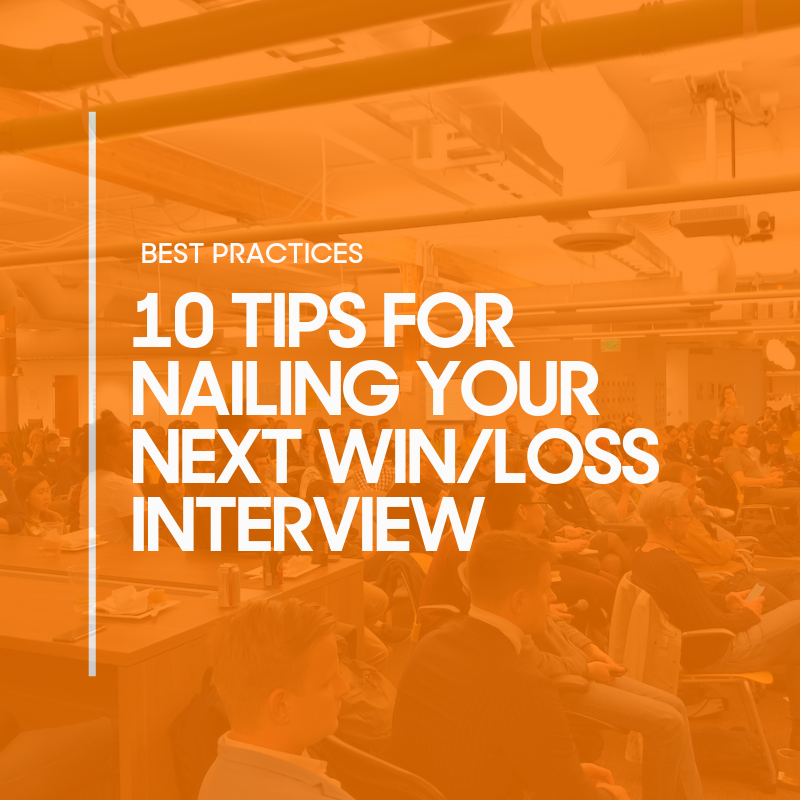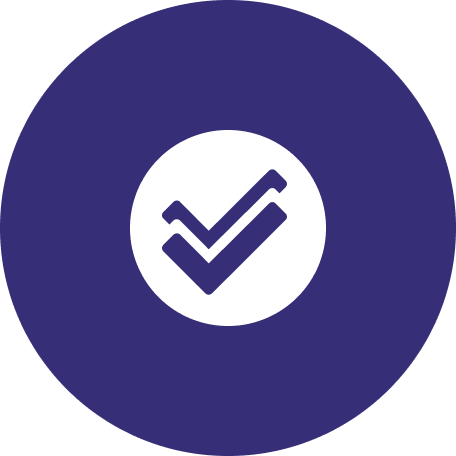Nailing Your Next Win/Loss Interview is Easier Than You Might Think
Like any other kind of interview, conducting a win/loss interview can be a stress-filled process. You only have a limited period of time in which to elicit as much useful information as possible from a buyer who’s likely a complete stranger. So, how do you make the most of this valuable opportunity? You need to put the interviewee at their ease and then keep them engaged and focused throughout the interview so that they feel comfortable in sharing their feedback—good and bad--on all aspects of their recent sales engagement.
At my company, DoubleCheck Research, an independent research analysis company, we’ve interviewed several thousand buyers on behalf of our enterprise software clients. Here are our 10 best practices for conducting successful win/loss interviews.
💬 Create a conversational interview guide
While interviews should be conversational and not scripted, it’s smart to go into each interview with a plan and a set of open-ended questions on hand. Think of these questions as the guardrails for the interview. They help to keep your conversation on track and ensure that you’re collecting insights that align well with your win/loss program learning objectives. By weaving in a set of common questions, you’re also in a great position to draw comparisons between different buyers’ interview responses.
One good rule of thumb when creating a conversational interview guide is to lay out the questions in chronological order so that they to align with the traditional Buyer’s Journey Framework.
🏆 Establish your authority through prior research
Being well prepared in advance of the interview is one key way of creating and maintaining a strong connection with the interviewee from the get-go. You want the interviewee to see you as a peer who is knowledgeable about the specific technology you’re going to discuss. You’ll also want to show the interviewee you have done your homework on the interviewee themselves (by checking out their LinkedIn profile), their company (via its website), and any information the buyer may have already shared. At DoubleCheck, we find that asking the interviewee to complete a short survey prior to the interview really helps to support a strong discussion. All your initial research will also help boost your confidence as the interviewer.
We also recommend doing a brief Google search on the buyer’s company and the specific technology they’ve evaluated. Such a search may indicate the level of experience the buyer’s organization already has with the technology. Take advantage of any information sales or other departments may have to share with you on this specific engagement, particularly why they think this deal was won or lost—the buyer’s recollections may confirm or contradict those perceptions.
👭 Develop your own empathetic conversational style
Don’t force yourself into any particular interview style, instead go with what works well for you and feels comfortable. If you’re someone who likes to engage in some brief chitchat before embarking on the interview proper, feel free to indulge if your interviewee seems open to that informal discussion. Interviewing is an art and you may find it very helpful to examine the different techniques other interviewers use, whether they’re your peers or in the media, to adopt what might work best for you and to reject what doesn’t feel natural.
Make the interview feel more like a conversation between two peers rather than a question-and-answer session. So, be empathetic in responding to the interviewee’s tone—sympathetic when they’re sharing some unpleasant part of their engagement or laughing along with them if they make a joke. The end result is that the buyer feels like they’re really being listened to and so they are likely to be more open in what they share. In providing a pleasant experience, the interviewee may also be willing to re-engage in the future should there be any follow-up questions or later on to recount the progress of a technology project.
⌛ Be respectful of the interviewee’s time
In setting up the interview, make sure that the buyer is aware in advance of the time allotted to the conversation. A typical win/loss interview tends to run between 20 and 30 minutes. As the interviewer, make sure that you have some free time immediately before and after the call so you can start the interview promptly and then you can also go longer than the time slot, if the buyer wishes to do so.
Avoid scheduling back-to-back interviews at all costs since your first interview may start late or run long and you don’t want to have to cut the interviewee off when they’re in full flow with their win/loss feedback. Should a buyer arrive late to a scheduled interview, ask them at the start of the conversation what their time constraints are and work within those limits. Should you find yourself with less time than initially expected, prioritize the questions to ask the buyer. Pick up on any subtle verbal clues the interviewee may give that they’ve provided all they can on a particular issue so you can move onto other areas. Also, use your intuition to be aware if the interviewee is becoming impatient and is eager to conclude the interview.
💪 Make a strong, clear start
One way to guarantee a strong beginning to the interview is for you to have one or two sentences prepared which identify who you are, your role, the purpose of the interview, a few words on how you prepared for the interview, and a short explanation of what will happen with the feedback they provide. Creating a safe and open environment for your discussion is critical and assuring the interviewee that their comments will be considered confidential is important. This is also the time to get any data privacy approval from the interviewee, for instance, when talking to buyers based in the European Union.
Following your opening statements, we recommend using two straightforward warm-up questions to lead into the main meat of the win/loss interview— so, ‘How would you describe your current role and responsibilities at Company X?’ and ‘As it relates to this evaluation, how would you describe your role?’ Note the use of open-ended questions, which help draw out interviewees, and is a technique we suggest you use throughout the interview.
👂Be fully present throughout the interview
Ensure that you have no distractions at all during the conversation, meaning that you’re in a quiet place and focusing all your attention on what the interviewee has to say. Even if you’ve heard some of what the interviewee is sharing many times before, what they’re disclosing is new for them.
Practice active or attentive listening so that you can explore and probe or later go back to any throwaway comments the buyer may make early on in the interview. One tip for being fully present is to take notes, even if you’re recording the call, so you’re concentrating on what the interviewee is saying in the moment as well as on their overall take on the sales engagement.
🤓 Identify and work with the individual interviewee’s response style
Every buyer has a different approach to how they tell their win/loss experience. Some buyers may adhere neatly to the Buyer’s Journey Framework as laid out in your interview guide, while other interviewees may present a more disjointed approach. Be guided by the interviewee and how they respond to your questions.
Some buyers may be very confident, fast-talking, and fully at ease in discussing their sales engagement. The trick here may be keeping these interviewees on track. With other buyers, they may start out as somewhat uncommunicative and so require time to warm up before they’re ready to share their experiences. The key with these types of interviewees is to work to their style and never show any impatience. Don't be afraid of introducing a moment of silence during an interview. Many interviewees require time to gather their thoughts and a pause can also help coax more reticent interviewees out of their shells.
🛂 Follow the 10/90 rule, but remain in control
We follow the 10/90 rule re ratio of time in our win/loss interviews, meaning that the analyst typically speaks for 10 percent of the time, while the interviewee talks for 90 percent. This ratio may be harder to achieve with less forthcoming interviewees, but aiming for 20/80 would work well in these cases to ensure that you’re still getting plenty of insight out of the interviewee. Be careful to select interviewers who tend to be more concise. Those with the gift of gab may need to temper their style to achieve a good ratio.
As the interview progresses, ensure that you keep the interviewee focused on answering the questions that align with your learning objectives and conversational interview guide. In that way, you can probe deeper into those answers with specific follow-up questions so you can gather as much valuable and relevant feedback as possible.
⛔ Never contradict the interviewee
One thing to bear in mind is that you’re capturing the buyer’s perceptions and experiences. You may hear things that directly go against what you may already know about a product and its functionality, but please hold back from pointing this out to the interviewee.
Discovering what buyers think about a vendor and its solutions and what they’ve taken away from product demos and discussions can be very different from what the vendor’s sales team may think they’ve communicated. Win/loss interviews often relay this ‘communications gap’ very clearly so that vendors can work to address and try to forestall misperceptions in future.
🏁 End strong
Among your final questions should be an open-ended ‘Is there any other feedback you’d like to share?’ or ‘Are there any areas of the engagement we’ve not yet talked about that you’d like to discuss?’ We know from experience that some of the most significant interview insights may come right in the final minutes of the conversation. For instance, what may have seemed to a vendor’s sales team as a completely lost deal may in fact be a salvageable engagement within the next year according to the interviewee.
End your win/loss interview with a heart-felt thank you to the interviewee. Also, ask if they would be open to a follow-up discussion in six months. Happy interviewing!
Want to learn more about win/loss analysis? Check out some of our other awesome content.
Become a DoubleCheck Insider!


